- Swastik Clinic, Ahmedabad, GJ, IND
- Call: 8849867169 (For Appointment)
- Mon - Sat: 10 AM - 08 PM
- Sun: Only Emergencies
Interstitial Lung Disease – Causes, Diagnosis & Treatment

Interstitial Lung Disease – Causes, Diagnosis & Treatment
What is Interstitial Lung Disease (ILD)?
Interstitial Lung Disease is a group of disorders that cause progressive inflammation and/or scarring of lung tissue. Such damage can affect your ability to breathe and to get adequate oxygen into the blood stream. ILD is more common in adults, but can rarely occur occurs in children.
ILD may be limited to the lung, or it can be related to a condition that may affect other parts of the body, such as rheumatoid arthritis or sarcoidosis.
What causes interstitial lung disease?
More than 200 causes of ILD have been identified. Because ILD includes many disorders, it can be categorized based on the cause. Below is the categorization:
ILD related to another health disorder
Some people develop ILD as a result of having an autoimmune disease (the immune system harms the body) which includes rheumatoid arthritis, polymyositis/dermatomyositis, scleroderma, lupus and sarcoidosis.
ILD caused by breathing in harmful substances
People who breathe harmful substances such as coal dust, asbestos, tobacco smoke or hairdressing chemicals may develop ILD.
Genetic ILD
A genetic ILD occurs when the disease is passed down among family members.
Idiopathic ILD
Idiopathic means the cause is not known and it affects people with 60 or more age.
Symptoms of ILD
The most common symptoms of ILD are:
- Shortness of breath that may worsen over time
- Dry cough
- Weight loss, joint and muscle pain, and fatigue
Screening & Diagnosis of ILD
To diagnose ILD, your pulmonologist will study your thorough medical history and perform a physical exam, looking for the signs and symptoms of interstitial lung disease such as rales (sounds heard with the stethoscope).
Other diagnostic tests include:
- Pulmonary function tests
- Blood tests
- CT scan of the chest
- Bronchoscopy
- Echocardiogram
- And possibly surgical lung biopsy
Interstitial Lung Disease – ILD Treatments
Treatment for ILD is designed to preserve the lung’s ability to function and keep the disease from getting worse. Depending on the specific cause and progression of your diseases, treatment may include:
Medications – It can help improve lung function by reducing inflammation and/or fibrosis.
Oxygen Therapy – Extra oxygen delivered through a tube in the nose can make breathing easier. This therapy raises the blood’s oxygen levels.
Pulmonary and exercise therapy – Breathing exercises and increased physical activity can improve lung fitness.
Lung transplant – Patients suffering from advanced ILD may also be referred for lung transplantation.
Because ILD can commonly involve comorbidities (including obstructive sleep apnea, pulmonary embolism, osteoporosis, and pulmonary hypertension), we work closely with the patients to provide the most comprehensive care.
Recent Posts
Archives
- April 2022
- January 2022
- December 2021
- November 2021
- August 2021
- July 2021
- June 2021
- May 2021
- April 2021
- March 2021
- February 2021
- January 2021
- December 2020
- November 2020
- October 2020
- September 2020
- August 2020
- July 2020
- June 2020
- May 2020
- April 2020
- March 2020
- February 2020
- January 2020
- December 2019
- November 2019
- October 2019
- September 2019
- August 2019
- July 2019
Categories
Recent Posts


I Got Covid-19 & Have Asthma – What Now?
09th Jan 2022
